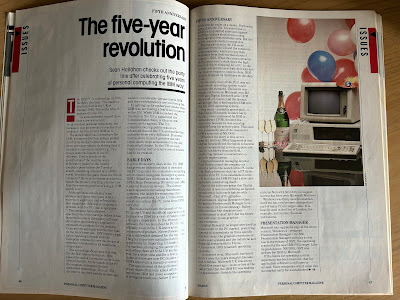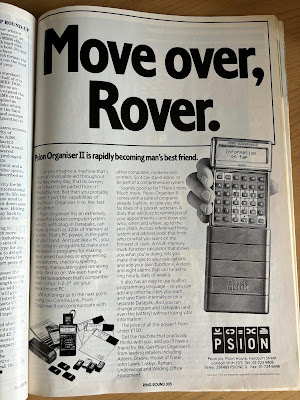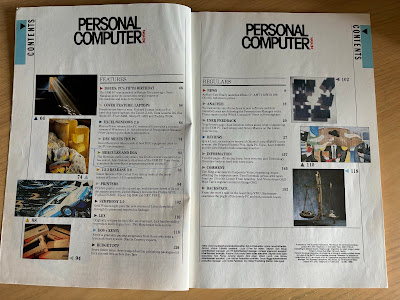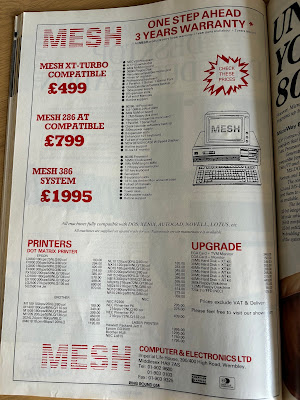Personal Computer Magazine was a free of charge publication for suitably qualified PC owners (VNU Business Publications' words, not mine), or, at the time of this issue, via a subscription of £21 per annum. I remember reading several issues of this magazine as I used to know a guy who was a freelance programmer in the financial sector back in the early to mid 90's, but this very early issue was way before that time.
It certainly looks like a 1980's business publication - and to be honest, despite the slightly sterile aesthetic, hasn't dated that much in my eyes (although they are very tired eyes...). Portables are front and centre this month, alongside the new Olivetti M380T (a quick look rather than a full review, and I've just noticed what they were asking for it!), and the spaff-tastic opportunity to experience Microsoft Excel and Windows 2.0. These, gentle reader, were far more simple times.
Headlining the news section was the glorious coming of dBase IV, much to the relief (I presume) of the 100,000 UK users of dBase III, and the first to offer SQL. Yay... said no-one, ever. Arriving in the summer, you could choose from either the PC-DOS/MS-DOS version or the wondrous OS/2 equivalent. Either would set you back £595 for the basic edition, £895 for the developers or the LAN pack.
 |
| Can you not feel the excitement for dBase IV??? |
Olivetti were dropping their prices (8086 models down 11%, 286 down 3-5%, 386 staying steady), Compaq were trying to get OS/2 into users hands (at a £235 suggested resale price for v1.0!), whilst AMT (no idea) were boasting of their 32MHz 386. If you can smell marketing bollocks, you'd be right. That "32MHz" 386 was actually a 16MHz part overclocked to 25MHz then paired with 80-nanosecond RAM set at "zero-wait state" for a Landmark benchtest equivalent of said 32MHz. At £3,995 for a 2Mb RAM, 40 Mb hard drive and an EGA display, was it a) really worth the risk for such shenanigans, and b) who the fuck took Landmark ratings as gospel??? *
 |
| AMT, if not exactly lying, are fibbing to a high degree. |
At least Real World Graphics were having a laugh with their £4,500 PC8000 graphics card. Featuring the ever-popular "whatever can we use this for?" Inmos T800 Transputer, this 8-bit card could supply 256 colours out of 16 million at a resolution of 1,024x1,280. Heady stuff for '88, but it couldn't do EGA or VGA, and you'd need a seriously business case for chucking that amount of dosh around. There again, a monitor capable of taking advantage of that capability was not exactly cheap either!
 |
| Back when word processing was a serious undertaking. |
There are a trio of new analysis features adding commentary to contemporary developments. The first covers Hercules products in relation to the new market for "compatible" VGA products. Hercules themselves had launched an add-on card that would work a treat with the forthcoming Wordperfect v5.0 and provide users with all sorts of type style goodness, especially compared to the limited EGA offering. Nice idea, but the tumult over graphical standards would not last long enough for such productivity-focused goods to succeed, and the kerfuffle over VGA standards would be sorted as the 90's dawned. The second talks about the recent Which? Computer Show at the NEC in Birmingham. Despite 20MHz 386's stealing the hardware show, there was little to surprise the 51,500 visitors. Just imagine that level of attendance at a UK computer event now... Finally, there's a whole page dedicated to interface standards prompted by the establishment of Windows as the default adopted by OS/2's Presentation Manager. The article delves further into DECwindows and Macintosh, but given cynical hindsight, all I can add is, "Bless!".
 |
| A lofty tower indeed! |
Thence follows monthly updates from the IBM PC and Lotus User Groups, before the mag hands over to some quick look reviews, including the exclusive on the Olivetti M380/T. Exclusive is the right word here, as the 20MHz 386 tower packs in ten (10!) expansion slots: four 16-bit AT slots, two 8-bit PC-compatible slots, and four "Olivetti proprietary" 32-bit slots that can also double as existing 8/16-bit ones. No spoilers but that format didn't last the distance. A single 4Mb RAM board and EGA graphics are decent enough, and you can add up to 64Mb of 32-bit RAM as well as five drives (three half-height 5.25" bays, two full height). It would have made a cracking server for the time, and for a list price of £7,436, certainly lived up to the definition of exclusivity.
 |
| Happy UK birthday to you... |
A product update section gives further details on new and existing wares before the first feature proper of the issue arrives: The Five Year Revolution - aka, the PC's fifth birthday in the UK. A cracking look at how the IBM PC came about and its impact, the final paragraph is a hindsight-baiting hoot - "The next five years of personal computing with PS/2 and OS/2 will be more orderly and less erratic - and probably not as much fun." I mean, it wasn't as much fun as IBM wanted it to be: Microsoft bailed on OS/2, Wintel became very much a thing, and the commoditisation of PC hardware meant that even when IBM tried to get back into the price competitive market, it ended up being just one of many box shifters out there. That said, in no way can you blame the writer of this article for their view - OS/2 looked to be the future.
 |
| And portables have certainly progressed... |
The cover feature next and a small group review of portable PC's. This is a lovely period piece in that it questions whether there is an actual market for portables aside from the "obvious applications such as sales and surveying" - and in those days, aside from management bragging rights, the use case for portables pretty much boiled down to those two niche markets. There are many technical reasons why laptops of 1988 were compromised tech. Display tech is given the first kicking, with gas plasma displays using a minimum of 40 watts for that (frankly superb and that's a hill I will die on) screen aesthetic, hence mostly limited to mains powered devices. Super-twisted LCD screens were the most common type but very prone to ghosting - if you've ever had the pleasure of a passive matrix LCD screen, you'll know the pain of hunting the cursor. If you haven't, be thankful you're under forty (and spoilers, it's always your back that goes first, young 'un). Colour is the future, but as with most cutting edge tech, the first colour laptops (albeit with passive matrix displays) would cost several thousands pounds.
Processors, memory and storage are up next, Low power versions of 8086, 8088 and 286 chips abound, and memory specs are starting to feel the pinch with the approach of OS/2 - 2Mb is becoming a common amount and even 8Mb is being touted as a near term norm. As for storage, despite their propensity of gobbling up battery charge, hard drives are starting to appear as a standard fit, and you can certainly understand why considering a) the then-potential users of laptops, and b) the prices being paid for portability. Battery tech, though, is letting the side down. Nicad cells are expensive but offer a more sustained discharge compared to lead acid batteries, but even then, you're looking at two hours max away from a wall socket.
But that didn't mean companies wouldn't sell you something that could be lugged about. Data General offers its DG One Model 2T, the lightest (cough) machine in the group. At 12lbs, measuring 3 x 14.8 x 11.8 inches, it's svelte and compact compared to the others. It is, however, relatively slow (7.16MHz 80C88-2 processor), and not even the presence of a 20Mb hard disk and a reasonable super-twist screen can make up for the 512Kb RAM or the absolutely dire keyboard. The 10 Nicad's that power this beast offer about two and a half hours use with an unspecified amount of HD thrashing. The price? £2,538.
 |
| The Sharp is looking particularly sharp... |
Toshiba were, at this point in time, the portable PC builder, and its T3100 cuts a dashing 3.1 x 12.2 x 14.2 inch figure in a 15lb body. An 8MHz 286, full 640Kb RAM and 20Mb hard drive offer a decent spec, and the 640x400 CGA gas plasma does a great job. The only downside, apart from the price of £2,995, is that it is a main-only machine.
Sharp were another early big name in portables, rocking up with their PC-4251. At £1,949, it's the cheapest on offer, but a dire backlit screen, slow 8088 level processor and a basic 512Kb of RAM hold it back. The 20Mb hard drive is handy at the price, but the lead acid battery pack is responsible for a short two hours on the move. You could switch off the back light, but that would just make the screen worse than it already is.
 |
| Great screen, if you can find it in that lid. |
Zenith's Z-183 has a cracking LCD screen, 640Kb RAM and a 20Mb Winchester drive. Battery life can run up to three hours (more with an optional extended battery pack), and although it's only an 8088-class laptop, is bloody good value for £2,599, especially with that noteworthy keyboard.
 |
| Actually, compared to the Zenith, the Flyer asks "What screen?" |
Finally, the Flyer A286 (wonder what CPU it packs?) is a transportable, coming in at 18lbs and taking up 5 x 16.5 x 15.3". The screen, for that is that tiny rectangle in the lid) ain't great, but the presence of that 10MHz 286 and 1Mb of RAM make up for it. The keyboard is good too, and there's room for a single full length or two half length expansion cards internally. The trade off is that this is mains-only and, combined with the price of £2,795, make it questionable value compared to more mobile machines. Buyers could take their pick but the time of the portable had not yet arrived...
 |
| This is a seriously interesting read, honest! |
The features continue with a look at Excel's future with Windows (so, so quaint), DECs response to IBM with a pivot to compatible machines and networking, and an absolutely fascinating comparison between Hercules graphics and the EGA standard. No, seriously, that wasn't sarcasm. At a time when the VGA standard was still brand new and most users preferred capability over show, the Hercules option made perfect sense. There is a brief nod to VGA, but the conclusion is set firmly at promoting Hercules for business users. The additional technical info provided is interesting too.
 |
| If Clarkson had written for computer mags. |
Lotus 1-2-3 release 3.0 is given a close examination, and although it's an informative article, the lack of any screenshots is a shame. Indeed, the repeated use of a mucked about picture of an actual Lotus car is the only imagery present. I thought this was a computer magazine???
 |
| Some "Everyday's" are more equal than others. |
Four high end dot matrix printers are up for review, and as someone who first experienced home printing via an Amstrad DMP 2000 connected to my CPC, these would have been the Rolls Royce equivalents, albeit tagged as "Everyday options", which I'm sure they were for their intended audience. From the 18-pin Philips GP10 at nearly £2k to the "budget" £1,045 24-pin Epson LQ-2500, these would all have suited many a business, and dealers sold them at slightly lower prices (that Epson is advertised a few pages on for £763 ex VAT).
 |
| A difficult decision in 1988. Less so in 1992. |
A history and comparison between Xenix and DOS is another fantastic feature, and is a lovely snapshot of the multi-user multi-tasking domain in the years before the 90's changed things around. Following that is a neat little look at a group of Desktop Publishing Software packages, and the book review round up covers tomes about the ADA programming language, DOS, and Ventura Publisher.
 |
| That turbulence would end up akin to a fart in a hurricane. |
Finally, three Comment pages give updates on a trio of contemporary issues. Tim Ring offers advice to Management Information Systems managers about the fast paced nature of the end user, Tom Foremski proffers a view of the American market's response to IBM's PS/2 (whilst also noting Amstrad's push into that country's ferociously volatile low-end arena), and Mike Tait asks if you can handle the move to OS/2. As Microsoft would later have it, no you could not.
 |
| No, and it won't matter anyway. |
Adverts time, and because this is a business-centric magazine, it's not all Alan's cheap kit either!
 |
| Just Google him, youngsters, just Google him. |
Compaq are hawking their Deskpro 386/20, comparing it to 1978's most powerful PC, Geoff Capes. You can guess which is the winner, but the most interesting thing stated is the machine's suitability for running OS/2. Yep, the world was waiting for the greatest leap in operating system development - and to be honest, outside of RISC OS, we're still waiting ;-)
 |
| You could do a lot worse, and for more money... |
Oh, Alan is advertising his wares, with a full page dedicated to the PC 1640, and to be honest, that "from £499" price tag was seriously good value for the time. Over the page is an ad for Amstrad's LQ 3500, and you can tell how much confidence they have in the product as they've knocked £50 off the RRP and bundled Wordstar 1512 with it... and no, the contemporary reviews I've seen were never kind to any Amstrad printers, no matter the price cuts or extras.
 |
| ... whereas you couldn't do much worse here. |
Dealer Visualex Ltd have a half page showing off Sharp's laptop range - and doesn't that look a beauty? Not to carry, obviously, and for £1,099 ex VAT for the pictured model, quite a chunk of change, but as noted in previous posts, there is something about the late 80's portable aesthetic...
 |
| Isn't that an absolute beauty? What do you mean, no? Heathen! |
Toshiba get in the act too, and it's a gas plasma that steals the show. Easily transportable with one hand (that built in handle is more than enough for the 18lb weight... obviously), it's the advertising statement at the end of the text that raises a chuckle: "Of course, the T3200 has the arrogantly understated designer look..." - Bloody hell. Tosh, calm down! Of course, this was the 80's...
 |
| Oh, gas plasma, my heart doth pine for thee... |
 |
| Sponsored by cat owners, naturally... |
Psion's Organiser II gets a full page in the company's struggle against domestic pet ownership, whilst Mesh are showing off their range of desktops. £499 for an XT compatible (Turbo, mind you, TURBO!), is competitive for the time, as is the £799 for the 286 AT (sans Turbo), but it's the upgrades where the money really comes in to play - £150 for a CGA card and suitable monitor would give you colour (ish), but £340 for the EGA equivalent? And if you wanted hard disk storage? Whoosh goes the overdraft! There's a £50 difference between a 20Mb XT kit and the same capacity for an AT machine, and none of the machines listed, not even that 386, comes with fixed storage. Compare the price of a Mesh XT with 20Mb of storage and an an EGA display, yours for £1,044 ex VAT, with an Amstrad PC 1640 ECD with 20Mb from a dealer a few pages prior: £969 ex VAT. It might not matter much to business users, but that's still a £75 saving.
Finally, just to prove that it wasn't all DOS computers, our old favourite Silica Shop have a full page ST ad showing off the 520 ST-FM at the bargain price of £260 ex VAT (£299 inc). For 1988, a superb price for a very good computer. The 1040 ST-F and Mega ST's were pricier (much pricier in the case of the latter), but each filled a gap in Atari's range.
So that was business in 1988, and aside from the anticipation for OS/2, so far so PC. Changes were coming, and as evidenced in previous posts, although the five tears prior to '88 were definitive for what the DOS PC actually was, the next five years would change the nature of the format beyond anything the average reader of this issue could have forseen.
Next time, we'll travel forward those five years and see what Personal Computer Magazine had to say then.
* Silica Shop advertised Amstrad Mega PC's rocking a 33MHz 486 SLC that bragged about it scoring 92MHz in Landmark v2.00. They only did this to tout the machine's greater powered compared to the 25MHz 386SX of the standard model, which itself "scored" 31MHz! Here's the ad:
 |
This, gentle reader, is known as marketing bollocks.





No comments:
Post a Comment